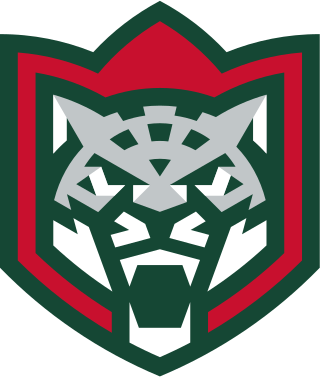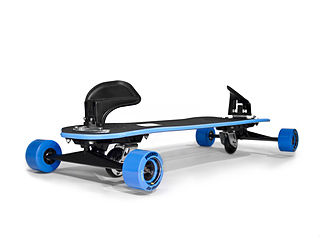
Snowboards are boards where the user places both feet, usually secured, to the same board. The board itself is wider than most skis, with the ability to glide on snow. Snowboards widths are between 6 and 12 inches or 15 to 30 centimeters. Snowboards are differentiated from monoskis by the stance of the user. In monoskiing, the user stands with feet inline with direction of travel, whereas in snowboarding, users stand with feet transverse to the longitude of the board. Users of such equipment may be referred to as snowboarders. Commercial snowboards generally require extra equipment, such as bindings and special boots which help secure both feet of a snowboarder, who generally ride in an upright position. These types of boards are commonly used by people at ski hills, mountains, backcountry, or resorts for leisure, entertainment, and competitive purposes in the activity called snowboarding.
Skis are runners, attached to the user's feet, designed to glide over snow. Typically employed in pairs, skis are attached to ski boots with ski bindings, with either a free, lockable, or partially secured heel. For climbing slopes, ski skins can be affixed to the base of each ski to prevent them from sliding backwards. Originally used as a means of travel over snow, skis have become specialized for recreational and competitive alpine and cross-country skiing.

Snowboarding is a recreational and competitive activity that involves descending a snow-covered surface while standing on a snowboard that is almost always attached to a rider's feet. It features in the Winter Olympic Games and Winter Paralympic Games.
Boardsports are active outdoor sports that are played with any sort of board as the primary equipment. These sports take place on a variety of terrains, from paved flat-ground and snow-covered hills to water and air. Most boardsports are considered action sports or extreme sports, and thus often appeal to youth. Some board sports were marginalized in the past. However, many board sports are gaining mainstream recognition, and with this recognition, they have gotten wider broadcasting, sponsorship and inclusion in institutional sporting events, including the Olympic Games.

Skiing, or traveling over snow on skis, has a history of at least eight millennia. The earliest archaeological examples of skis were found in Karelia and date to 6000 BCE. Although skiing's origins were purely utilitarian, the modern sport evolved from beginnings in Scandinavia. In the mid-1800s skiing became a popular recreational activity and sport. In the 20th century it was practiced in snow-covered regions worldwide, providing a market for the development of ski resorts and their related communities.

Kiteboarding or kitesurfing is a sport that involves using wind power with a large power kite to pull a rider across a water, land, snow, sand, or other surface. It combines the aspects of paragliding, surfing, windsurfing, skateboarding, snowboarding, and wakeboarding. Kiteboarding is among the less expensive and more convenient sailing sports.
A Snakeboard, also known as a Streetboard is a board that was invented in South Africa in 1989 by James Fisher, Simon King and Oliver Macleod Smith. The concept was to fuse the original skateboard with elements of snowboarding and surfing to create a fun riding experience. The first prototype was constructed using two square wooden boards, an old roller skate chopped in half, and a piece of plumbing pipe to join them together. Many variants were tried before manufacturing began. The first boards to be mass-produced were made from a strong plastic nylon known as Zytel ST801.
Ski boots are footwear used in skiing to provide a way to attach the skier to skis using ski bindings. The ski/boot/binding combination is used to effectively transmit control inputs from the skier's legs to the snow.

Mountainboarding (MTB), also known as dirtboarding, off-road boarding, and All-Terrain Boarding (ATB), is a well-established, but little-known action sport derived from snowboarding. The sport was initially pioneered by James Stanley during a visit to the Matterhorn in the 1990s, where snow was not available. A mountainboard is made up of components including a deck, bindings, four wheels with pneumatic tires, and two steering mechanisms known as trucks. Mountainboarders, also known as riders, ride specifically designed boardercross tracks, slopestyle parks, grass hills, woodlands, gravel tracks, streets, skateparks, ski resorts, BMX courses, and mountain bike trails. It is this ability to ride such a variety of terrain that makes mountainboarding unique from other board sports.

A snowskate is a snow sliding device which can be described as a hybrid of a snowboard, and a skateboard. Unlike a snowboard which uses bindings to secure the board to a riders feet, a snowskate is typically bindingless. The lack of bindings allows the rider to perform more skateboard-like flip tricks on the snow as opposed to what can be done on a traditional snowboard. Although the bindingless nature of the snowskate allows for the aforementioned skateboard-like tricks, snowskates can also be ridden in a style similar to traditional snowboarding, but with the added challenge and freedom of riding and carving bindingless. There are many types of snowskates depending on the brand and styling of riding, but the most common are single deck and bi-level snowskates.
Jake Burton Carpenter, occasionally also known as Jake Burton or Jakie, was an American snowboarder, founder of Burton Snowboards, and one of the inventors of the modern day snowboard. A native of New York, he grew up in Cedarhurst, New York.
Burton Snowboards is a privately-owned snowboard manufacturing company that was founded by Jake Burton Carpenter in 1977. The company specializes in products aimed at snowboarders, such as snowboards, bindings, boots, outerwear, and accessories. The company, whose flagship store is in Burlington, Vermont, was privately owned by Jake Burton Carpenter, until his death in 2019, and by his wife, Donna Carpenter, who has been active in the business since 1983.

Hockey Club Ak Bars, also known as Ak Bars Kazan, is a Russian professional ice hockey team based in Kazan. They are members of the Kharlamov Division of the Kontinental Hockey League.

A splitboard is a snowboard that can be separated into two ski-like parts used with climbing skins to ascend slopes in the same way as alpine touring or telemark skis. The main difference is that a splitboard will have an additional metal edge for extra grip in ski mode. Unlike normal snowboards, it will also have nose and tail clips, split hooks, and touring mounts. Similar to cross country skiing, splitboarding allows free heel movement and with skins attached to the bottom of the skis, provides uphill traction. The two halves can then be connected to form a regular snowboard for descent. Splitboarding culture often focuses on the idea of using your own power to access the backcountry usually on unmaintained trails.

U.S. Snowboarding, the snowboarding arm of the United States Ski and Snowboard Association (USSA), is committed to the progression of snowboarding by providing athletic programs, services, and competitions for male and female athletes of all ages, coast-to-coast. Since the inclusion of snowboarding as a medal sport in 1998, U.S. Snowboarding has accounted for 14 Olympic medals, including the sweep of the podium in men’s halfpipe in 2002 and a best in the world performance of seven medals in 2006.

Backcountry snowboarding is snowboarding in a sparsely inhabited rural region over ungroomed and unmarked slopes or pistes in the backcountry, frequently amongst trees, usually in pursuit of fresh fallen snow, known as powder. Often, the land and the snow pack are not monitored, patrolled, or maintained. Fixed mechanical means of ascent such as ski lifts are typically not present, but alternative means such as splitboarding, hiking, snowshoeing and helicopters ("heliskiing") are sometimes used to reach the mountain's peak.

A freeboard is a specialist skateboard designed to closely simulate the behavior of a snowboard. Freeboards were developed to allow snowboarders to transition to skateboarding without the need to adapt to a smaller deck and narrower wheel-base.
This glossary of skiing and snowboarding terms is a list of definitions of terms and jargon used in skiing, snowboarding, and related winter sports.
Sherman Robert Poppen, also known as Sherm Poppen and Sherman Poppen, was an American engineer and inventor. He was known for inventing snowboarding in 1965.











